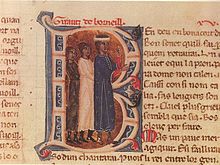Giraut de Bornelh
- Giraut de Bornelh
-

"Girautz de Borneill" (comme il est écrit en haut) dans un recueil de chants du
XIIIe siècle.
Guiraut de Bornelh (1138 - 1215) est un troubadour si fameux que ses contemporains l'appelaient le maître des troubadours
Biographie
Guiraut est né dans une famille modeste et a fait des études dans une abbaye limousine. Il a appartenu à la cour d'Alphonse II d'Aragon. Il a accompagné le comte Ademar V dans les Croisades entre 1188 et 1189. Il a été un temps à la cour du roi de Castille Alphonse VIII. Il s'est retiré dans le Limousin en 1192.
L'œuvre de Giraut
Il a été classé par Dante comme le second meilleur troubadour (après Arnaut Daniel). Ont seulement survécu quatre de ses mélodies. L'aube Reis glorios est une des plus connues. Elle est exceptionnellement belle.
Liens externes
Wikimedia Foundation.
2010.
Contenu soumis à la licence CC-BY-SA. Source : Article Giraut de Bornelh de Wikipédia en français (auteurs)
Regardez d'autres dictionnaires:
Giraut de Bornelh — (c. 1138 ndash; 1215), whose first name is also spelled Guiraut and whose nickname Borneil(l) or Borneyll, was a troubadour, born to a lower class family in the Limousin, probably in Bourney, near Excideuil. Connected with the castle of the… … Wikipedia
Giraut de Bornelh — (Guiraut de Borneil) (ca. 1138–ca. 1212) Called by his contemporaries the “master of the TROUBADOURS,” Giraut de Bornelh was an influential Provençal poet whose 77 extant lyrics are the largest number to have survived from any individual… … Encyclopedia of medieval literature
Planh — Un planh est une forme troubadouresque consistant en une lamentation funèbre qui pleure la mort d un ami, d un personnage fameux, etc. Le planh a ordinairement la structure thématique suivante: Invitation au planh. Lignage du défunt. Énumeration… … Wikipédia en Français
trobar leu — Trobar leu was a style of TROUBADOUR poetry that was characterized by simple, natural, and accessible diction and relatively simple verse forms. It was a style intended to appeal to the broadest possible audience. The term comes from the… … Encyclopedia of medieval literature
Raimbaut of Orange — (c. 1147 ndash; 1173), or in Occitan Raimbaut d Aurenga, was the lord of Orange and Aumelas. His properties included the towns of Frontignan and Mireval. He was the only son of William of Aumelas and of Tiburge, daughter of Raimbaut, count of… … Wikipedia
noise — [ nwaz ] n. f. • fin XIe; « bruit, tapage » en a. fr.; lat. nausea « mal de mer » ♦ Vx Querelle, dispute. « C est une noise que vous nous cherchez » (Jouhandeau). « de petites noises » (Duhamel). ♢ (1611) Mod. Loc. Chercher (des) noise(s) à qqn.… … Encyclopédie Universelle
Raimbaut d’Orange — (Raimbaut d’Aurenga) (ca. 1130–1173) Raimbaut III, count of Orange, was a TROUBADOUR from the region of Provence. He was lord of the town of Omelas, west of Montpellier, and held the castle of Cortezon between Orange and Avignon. Here he kept… … Encyclopedia of medieval literature
tenso — (tenson, tenzone) The tenso was a form of poetry originating in 12thcentury Occitan in the poetry of the Provençal TROUBADOURS. Eventually the form spread to poets in Italy and in Sicily. The term, meaning “dispute”or “rivalry” in Provençal,… … Encyclopedia of medieval literature
Liste de compositeurs français — Classement alphabétique Sommaire : Haut A B C D E F G H I J K L M N O P Q R S T U V W X Y Z A … Wikipédia en Français
Alamanda de Castelnau — Alamanda was a trobairitz whose only surviving work is a tenso with Giraut de Bornelh called S ie.us qier conseill, bella amia Alamanda . In the past she was usually considered fictitious and the tenso was considered a piece of Giraut s writing.… … Wikipedia
 "Girautz de Borneill" (comme il est écrit en haut) dans un recueil de chants du XIIIe siècle.
"Girautz de Borneill" (comme il est écrit en haut) dans un recueil de chants du XIIIe siècle.
